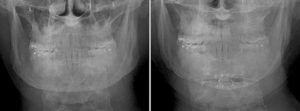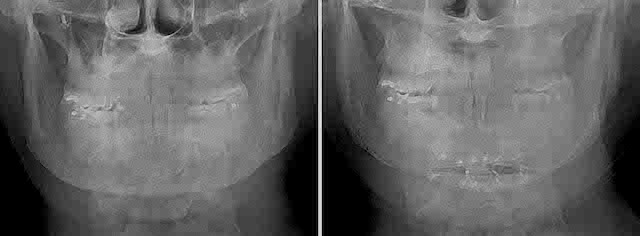Bony jaw reduction consists of different techniques in the location and extent of lower facial reshaping than does masseter muscle reduction. Known as jaw shaving, jaw contouring, or most commonly V-line surgery, this collection of procedures removes bone from the length of the lower jaw to change its shape and size.
Jaw bone reshaping can be done at the front (chin), back (jaw angles) or both in which different techniques are used to do so. At the chin the bone can be reshaped using external contour reductions (shaving) or by osteotomies and removal of internal segments of bone. (t-shaped genioplasty)
Each chin reshaping approach has its advantages and disadvantages but the most important determinant in choosing a procedure is what dimensions of the chin needs to be changed for the desired look. If the chin only needs to be narrowed, with or without vertical shortening, the outer edges (lateral tubercles) can be removed by bone shaving through either an intraoral or submental approach. However if the chin needs to narrowed, advanced and have any vertical lengthening, these 3D changes requires the chin bone to be sectioned into three pieces and put back together with plate and screw fixation. (this is the front end of traditional v-line surgery)

Posterior jaw reduction by shaving or by removing the outer layer of bone changes the width of the jaw but not its vertical length. The jaw angle shape is kept intact but it becomes less wide. The amount of jaw reduction change is less dramatic but is more aesthetically appropriate for jaw shapes that are not unduly wide or flared and doesn’t have a low jaw angle. It is often what is better suited for the patient who has a normal mandibular plane angle and has little risk of resulting in an over resected jaw shape.
The key to a successful bony jaw reduction is to match the technique with the dimensional requirements needed for the desired change. This not only requires preoperative x-rays (panorex, lateral cephalogram or 3D jaw CT scan) but computer imaging to determine what magnitude of jaw reduction change the patient desires. While under- and over resection results can occur, by far the most common revisional jaw reduction patients I see is when too much has been done. This almost always is when traditional v-line surgery has left the patient with over resected jaw angles and chin that is too narrow or elongated. This can be a function of overly aggressive bone reduction but more commonly occurs because it was not the right technique for the patient’s natural jaw shape.
Dr. Barry Eppley
Indianapolis, Indiana




